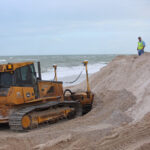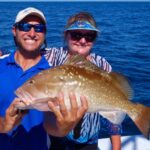INDIAN RIVER COUNTY – The cold snap from earlier this monthr has left hundreds of fish dead and floating in the county’s waterways. And now health and environmental officials are urging the public to use caution when cleaning up the floaters.
The Florida Fish and Wildlife Conservation Commission recently announced that it would loosen restrictions to allow people to pick up and dispose of the fish, which by now are beginning to rot and cause a foul odor.
“We took away the worry,” said FWC spokesman Lee Schlesinger of people getting caught with fish they should not normally have.
Beyond allowing people to scoop up the fish any way they want, the FWC has not said how people should dispose of the decaying carcasses.
“That’s a local issue,” Schlesinger said, explaining that each county might have its own suggestions for disposal.
For Indian River County, residents have a couple options. They can either take the fish to the county landfill where it will be buried with other trash or they can use them as personal fertilizer in gardens.
They should not, however, eat the fish.
Charles Vogt, an environmental specialist with the county’s health department, said that by now, bacterial and other organisms have begun the process of breaking down the floating fish. Eating the fish would certainly cause – at the least – intestinal discomfort, he added.
As for handling the fish, Vogt said people should use common sense. They should wash their hands after touching the carcasses before making a sandwich, for instance, he explained.
So far, the Indian River County Health Department has not seen a negative impact to the public’s health due to the rotting fish, though it is routinely monitoring the beach water quality around the county.
Last week’s tests, Vogt said, were fine – at the peak of the fish kills. This week, the fish that seagulls and crabs haven’t yet eaten are decaying in the water and along the shorelines.
Whether or not the decomposition would be enough to affect the water quality won’t be known until later today, Vogt said. If it is, beaches could be closed.
People who do go out on the water or walk the shorelines to collect the dead fish can put them in garbage bags and take them directly to the county’s landfill for disposal, Solid Waste Recycle Foreman Steve Brittingham said.
He does not recommend people put the fish in their regular trash for pickup due to the length of time the decaying fish might sit in their trashcans.
Brittingham said that the department would not be processing the fish as fertilizer or compost, but instead would be burying them “on the hill” – the main Class I landfill.
“We don’t know what they have in them,” he said of possible contaminants. They also cannot assume that all the fish died from the cold.
Schlesinger, from the Florida Fish and Wildlife Conservation Commission, said if the dead fish were left alone, nature would take clean up the mess on its own. However, “it’s human nature” to want to clean up because of the unsightliness and odor.
The wildlife agency has not yet determined the full extent of the damage done to the fish populations. And just how many fish were killed remains unknown.
“We’re scrambling to find out,” Schlesinger said of the environmental impact. Estimates range from “worst ever” to “normal,” he added.
While officials work to determine the loss to various fish populations, the FWC has either closed or extended the closure of fish season for snook, bonefish and tarpon – three species particularly hard-hit by the cold.
FWC Chairman Rodney Barreto said in a prepared statement that the closures would help protect the surviving snook that spawn in the spring and would give scientists the time they need to evaluate the damage to the three species’ populations.






